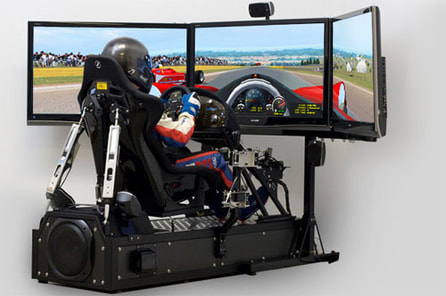
Simulated Tracks vs Real Tracks
As more laser scanned tracks starting coming out, I eventually got to start driving several of the same tracks, with the same car, in the simulator and in real life. Often mere hours apart. I would always be eager to load up the sim as soon as I got back from the track to do some comparisons. Of the laser scanned tracks I have driven, the claims of fraction of an inch accuracy appear to be true. The only differences I have noticed have been with smaller rippled surfaces such as curbs. For example, the exit curb of 10b at Road Atlanta appears to be smoother in sim than in real life and this alters my line from one to the other. This could be the way the tire model in the sim handles smaller bumps however, not any inaccuracy in the track model. We'll talk more about tire models shortly. Overall the tracks feel incredibly real though.
Another big development in track realism for sims came when they started to incorporate the ability to lock your view to the angle of the track instead of the car. This has become known as horizon locking. This mimics the way the brain experiences a track in real life, and allows a driver to see elevation and track camber changes. More information about the pros and cons of horizon locking can be found here. The inclusion of virtual reality support in sim racing brought yet another leap forward in realism for me. Where previously going from the real world 3D environment to a flat screen was always somewhat jarring and required an adjustment period, with VR the transition became seamless. Due to the accuracy of today's laser scanned tracks as well as the realistic immersion of VR, I would feel very confident taking to a new track in real life that I had only ever driven in a simulator.
Before moving on I wanted to offer a small, but very important tip to enhance the track realism in a simulator. Make sure you are setting your field of view (FOV) appropriately. Most default settings are way too high, and while a realistic setting might feel claustrophobic at first, it allows a driver to better see changes in rotation rate which is very important for car control. Some sims even have a calculator built in that sets your FOV correctly based on monitor size and view distance.
Cars & Tire Models
It's important to understand the crucial role of tires in not only overall car performance, but how they feel to drive. Not only are tires a huge part of this equation, but also the hardest to simulate. Most aspects of chassis simulation have been well understood and modeled accurately for quite some time now and other than the occasional bug, any true simulation most assuredly gets this right. Even more "sim-cade" type titles such as Gran Turismo and Forza Motorsport have a realistic chassis physics simulation at their core, they typically just have a more basic and forgiving tire model.
The tire models in different sims can vary greatly and even the most advanced tire models of today are still evolving. For years, my primary race car was a Spec Racer Ford. iRacing has a version of the car in their service so I've spent a great deal of time testing and training with it while comparing the experience to the real thing. While the sim version had a few odd behaviors in the beginning (I discovered an asymmetry in the vehicle balance which still hasn't been totally resolved), it always had the basic characteristics of the car. The evolving tire model however, gave it somewhat of a different feel with each update. It would change in cornering stiffness, stability past the limit, how well it handled curbs, and things of that nature. I always felt it behaved like a real tire might on any given day though. The feel of real world tires can change as well after all. Tires are still somewhat of a hand made product and so there is some variation in construction. Not to mention the changes they experience from different storage methods, heat cycling, and age.
While I am all for realism and want to see tire models continue to advance, even the relatively basic tire models of several years ago offered valuable training however. This is because, even if any certain simulated tire might not exactly match the real world counterpart, barring the odd exception, they still act like a tire and follow the basic laws of physics. They build force up to a certain point and then lose force if pushed too far. This means the physics of racing still apply and the correct techniques will work. When choosing a first sim, I often advise to simply go with whichever one offers the cars, tracks, and features you want as they can all provide good training. Then you can extend your training with additional sims later. You'll be able to see if you can recognize the differences in varying tire models and learn how to be fast in them all. This can teach adaptability. Personally, I now lean more toward sims and cars that have a more unforgiving tire model because training with a difficult car or tire can allow you to push your skills further than with an easy driving one. I actually wish a sim developer would create a special car made just for training that would make something like an F1 car seem tame by comparison.
Simulating Movement
I also see the lack of g-forces in a sim as a form of deficit training however. When we lose one sense, it sharpens our others. Most drivers report that when they hit the track in real life and their g-force cues come back, everything feels just a bit easier. I know from a personal standpoint that once I learned to focus on primarily visual cues in training, any improvements I made in my sim racing car control were immediately apparent in my real life driving as well. The reason this works is because what we see and feel on a race track is synergistic. The visual cues and g-force cues are providing the exact same information. The information of movement. While you can both see and feel the effects of changing tire forces on the car, only your eyes can tell you which direction those forces are moving you. For a racing driver, tracking that movement on track is what's key.
Benefits of Sim Training
One of the least obvious, but probably most important aspects of sim training is the ability to set static conditions to accurately track your progress. Once you reach the skill level where you are searching for fractions of a second, it can be quite difficult in real life to gauge where the time differences are coming from. Am I half a second quicker today because I'm doing something better or is it the tires, track, weather, or any number of other variables? While most modern sims allow you to set varied weather and track states, they also allow you to set static conditions if you wish and they provide you with an absolutely identical car every time. My Spec Racer Ford was a "spec" car where driver skill and setup are emphasized, but eliminating all variations between cars in real life is simply impossible. Sim racing provides the only true spec racing where any improvement in your times can be traced directly to some aspect of your driving. This is invaluable feedback that can take the guesswork out of the learning process.
I hope you enjoyed this article. If you are interested in a complete guide to the physics of racing, we also offer The Science of Speed book series, available through our bookstore or at popular retailers such as Amazon.
by Adam Brouillard



